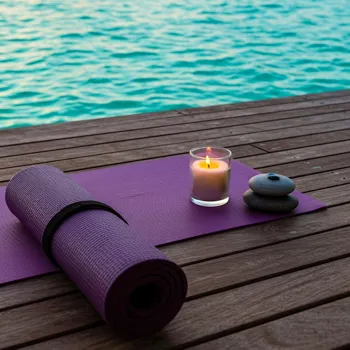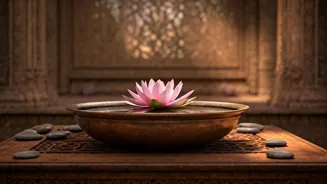Discover how mindfulness meditation can revolutionize your life! Dive into 6 transformative techniques. Your path to peace awaits!
In the hustle and bustle of modern Indian life, finding inner peace can
feel like a distant dream. From crowded trains and bustling markets to demanding jobs and family commitments, our minds are constantly bombarded with stimuli, leaving us feeling stressed, anxious, and overwhelmed.

But what if there was a simple, accessible way to navigate the chaos and cultivate a state of calm, clarity, and well-being? Enter mindfulness meditation, an ancient practice that's gaining immense popularity in India for its transformative effects on mental and emotional health.
Mindfulness meditation isn't about emptying your mind or achieving a state of blissful nothingness. It's about paying attention to the present moment without judgment, observing your thoughts, feelings, and sensations as they arise and pass, without getting carried away by them.
This simple act of awareness can have profound effects on your overall well-being, reducing stress, improving focus, enhancing emotional regulation, and fostering a greater sense of connection with yourself and the world around you.
Fortunately, incorporating mindfulness into your daily routine is easier than you might think. There are various meditation techniques that can be tailored to suit your individual preferences and needs.
Let's explore six effective methods that can help you embark on your journey to a more mindful and fulfilling life.
Breath awareness meditation anchors you to the present moment for inner peace
Breath awareness meditation is a foundational practice that serves as a gateway to mindfulness. It involves focusing your attention on the sensation of your breath as it enters and leaves your body. This can be done anywhere, at any time, making it a highly accessible technique for beginners.
Find a quiet place where you can sit or lie down comfortably. Close your eyes gently and bring your attention to your breath. Notice the rise and fall of your abdomen or the sensation of air passing through your nostrils. As you breathe, your mind will likely wander. This is perfectly normal.
When you notice your thoughts drifting, gently redirect your attention back to your breath. There is no need to judge yourself for getting distracted; simply acknowledge the thought and return to your breath.
Start with just five minutes a day and gradually increase the duration as you become more comfortable. The beauty of breath awareness meditation lies in its simplicity. By anchoring yourself to your breath, you can ground yourself in the present moment, regardless of what's happening around you.
It's a portable tool that you can use anytime you feel stressed, anxious, or overwhelmed. This practice is important as it forms the basics of the meditation practice. In doing this you can find yourself more at peace than before, the process of focusing just on your breath brings inner peace.
Body scan meditation fosters awareness of body sensations, promoting relaxation and self-care
Body scan meditation involves systematically bringing your attention to different parts of your body, noticing any sensations without judgment. This practice helps you cultivate a deeper awareness of your physical self, identify areas of tension, and release stress.
Lie down comfortably on your back with your arms at your sides and your palms facing up. Close your eyes gently and take a few deep breaths. Begin by focusing your attention on the toes of your left foot. Notice any sensations, such as tingling, warmth, pressure, or numbness.
If you don't feel anything, that's perfectly fine too. Simply acknowledge the absence of sensation. Gradually move your attention up your left foot, to your ankle, your calf, your knee, and so on.
Continue this process, systematically scanning your entire body, from your toes to the top of your head. As you scan each body part, notice any sensations without trying to change them. If you encounter pain or discomfort, simply observe it with curiosity and compassion.
The goal is not to fix or eliminate the sensation, but to simply be present with it. Body scan meditation can be particularly helpful for people who experience chronic pain, anxiety, or body image issues.
By cultivating a greater awareness of your body, you can learn to respond to its needs with more kindness and care. It is also a great way to relax your body after a long day of activity. This is a good way to be mindful of the body and helps to relieve the stress.
Walking meditation: combine mindfulness with physical activity for daily well-being
Walking meditation combines the benefits of physical activity with the practice of mindfulness. It involves paying attention to the sensation of your feet making contact with the ground as you walk, as well as your body's movements and the surrounding environment.

Find a quiet place where you can walk without distractions, such as a park, a garden, or even your own घर (home). Begin by standing with your feet hip-width apart and your arms relaxed at your sides. Take a few deep breaths and observe your breath.
When you're ready, begin walking slowly and deliberately. Pay attention to the sensation of your feet lifting off the ground, moving forward, and making contact with the ground again. Notice the weight shifting from one foot to the other.
You can also pay attention to your posture, the movement of your arms, and the feeling of the air on your skin. As you walk, your mind will likely wander. When you notice your thoughts drifting, gently redirect your attention back to the sensation of walking.
There is no need to judge yourself for getting distracted; simply acknowledge the thought and return to the present moment. Walking meditation can be a great way to incorporate mindfulness into your daily routine, especially if you find it difficult to sit still for long periods.
It's also a wonderful way to connect with nature and appreciate the beauty of the world around you.
Practice loving-kindness meditation for compassion and connection
Loving-kindness meditation, also known as Metta meditation, is a practice that involves cultivating feelings of love, compassion, and kindness towards yourself and others.

This practice can help you reduce negative emotions, such as anger, resentment, and fear, and foster a greater sense of connection and empathy. Find a quiet and comfortable place to sit. Close your eyes gently and take a few deep breaths.
Begin by directing feelings of loving-kindness towards yourself. Silently repeat phrases such as "May I be well," "May I be happy," "May I be peaceful," "May I be free from suffering." Visualize yourself surrounded by a warm and loving light.
Once you feel a sense of loving-kindness towards yourself, gradually extend those feelings towards others. Start with someone you care about, such as a family member or a close friend. Repeat the same phrases, but this time direct them towards that person.
"May they be well," "May they be happy," "May they be peaceful," "May they be free from suffering." Gradually extend your circle of loving-kindness to include acquaintances, neutral people, difficult people, and eventually, all beings.
Loving-kindness meditation can be a powerful tool for transforming your relationships and fostering a more compassionate and understanding world.
Sound meditation fosters presence and acceptance by focusing on surrounding sounds
Sound meditation involves focusing your attention on the sounds around you, without judgment. This practice can help you develop a greater sense of presence and acceptance, and can be particularly helpful in noisy environments. Find a comfortable place to sit or lie down.

Close your eyes gently and take a few deep breaths. Begin by simply noticing the sounds around you. You might hear the humming of a fan, the chirping of birds, the sound of traffic, or the voices of people talking. Allow the sounds to come and go without trying to change them or judge them.
As you listen to the sounds, notice how they affect your body and your emotions. Do they make you feel calm, agitated, or something else? Simply observe your reactions without getting carried away by them. If your mind wanders, gently redirect your attention back to the sounds.
There is no need to analyze or interpret the sounds; simply be present with them. Sound meditation can be a great way to cultivate mindfulness in everyday life, especially in situations where it's difficult to find a quiet place.
It can also help you develop a greater appreciation for the richness and complexity of the auditory world.
Gratitude meditation involves reflecting on the things you are grateful for in your life. This practice can help you shift your focus from the negative to the positive, boost your mood, and increase your overall sense of well-being. Find a quiet and comfortable place to sit. Close your eyes gently and take a few deep breaths. Begin by thinking of three things you are grateful for in your life. They can be big things, like your health or your family, or small things, like a beautiful sunset or a delicious cup of chai. As you think of each thing, take a moment to savor the feeling of gratitude. Allow yourself to truly appreciate the goodness in your life. You can also extend your gratitude to the people who have helped you along the way. Think of someone who has made a positive impact on your life and offer them your gratitude. Gratitude meditation can be a powerful way to cultivate a more positive and appreciative outlook on life. By regularly reflecting on the things you are grateful for, you can train your mind to focus on the good, even in the midst of difficult times.
Incorporating Mindfulness into Your Daily Life: Practical Tips
Starting a meditation practice can seem daunting, but it doesn't have to be. Here are a few practical tips to help you incorporate mindfulness into your daily routine:

Start small: Begin with just five or ten minutes of meditation each day and gradually increase the duration as you become more comfortable. Small steps can leads to big results.
Be consistent: Try to meditate at the same time each day to establish a routine. Morning meditation can be a great way to start your day feeling calm and focused.
Find a quiet space: Choose a place where you can meditate without distractions.

It could be a quiet corner of your घर (home), a park, or even your car.
Be patient: It takes time and practice to develop mindfulness. Don't get discouraged if your mind wanders or if you don't see results immediately. You may not see results immediately but patience will lead you to greatness.
Be kind to yourself: If you miss a day or get distracted during meditation, don't beat yourself up. Simply acknowledge it and try again the next day. The most important advice is to be kind to yourself.
Mindfulness meditation transforms life with six techniques for calm and clarity
Mindfulness meditation is a powerful tool that can transform your life. By incorporating these six techniques into your daily routine, you can cultivate a greater sense of calm, clarity, and well-being.

So, take a deep breath, close your eyes, and begin your journey to a more mindful and fulfilling life. It is a journey and it is going to be worth it.
AI Generated Content. Glance/InMobi shall have no liability for the content









